Feb 25, 2020 | advice, commentary, grading, registry sets
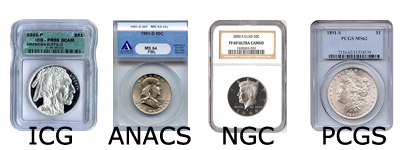 Last month, the American Numismatic Association announced that they have partnered with Numismatic Guarantee Corporation (NGC) to launch the ANA Coin Registry.
Last month, the American Numismatic Association announced that they have partnered with Numismatic Guarantee Corporation (NGC) to launch the ANA Coin Registry.
According to the ANA press release, the ANA Registry will accept coins graded by NGC and Professional Coin Grading Service (PCGS). The ANA Registry will be the only service that will allow both NGC and PCGS graded coins.
NGC has been a partner with the ANA for 25-years making it a natural choice to implement this program. Since NGC once allowed PCGS graded coins to count in their registry program, the facilities continue to exist for them to create a similar program for the ANA.
Participation is open to any collector. ANA members will receive a special icon of recognition next to their sets.
What is missing from the registry is the ability to include ANACS and ICG graded coins. Regardless of the opinion of these companies, they are competitive services to NGC and PCGS with a legitimate niche in the market.
By excluding ANACS and ICG, the ANA is telling the public that they decided who the best third-party grading services are. It is not the job of the ANA to pick market winners. Let the collecting public decide.
One advantage that ANACS and ICG has is that there are no memberships required to submit coins for grading. Anyone can directly submit coins to either company. Although ANA members can directly submit coins to NGC without an additional membership, only PCGS members can submit coins for grading.
Allowing open submission policies will allow for more people to participate. They can collect what they like and send it to ANACS and ICG without having to spend extra money or rely on a member. It will create greater access to casual collectors who might become more series if they can participate.
Could there be other reasons for not including ANACS and ICG? Since anyone can submit coins to ANACS and ICG, how will the dealers make money? If a collector buys a coin online or from another collector and sends their coins to ANACS or ICG for grading, how will the dealers make money?
Further, dealers have their own biases. They decided which grading service they like the best based on many factors, including perception and financial reasons. Whatever these reasons are should not be the policy of the ANA.
If the ANA is to fulfill its mission to encourage people to study and collect money and related items, then they cannot be picking market winners and losers. The ANA must revisit this policy and include the entire market without bias.
Sep 22, 2009 | grading, registry sets
In an attempt to try to boost their business, the Professional Coin Grading Service (PCGS) has announced the launch of the “Everyman” category as part of their PCGS Set Registry competition. The main rule of the “Everyman” Collection are classic coins (mostly pre-1964) not grated higher than AU-58 by PCGS.
PCGS has been running their Set Registry since 2001. The PCGS Set Registry will only accept coins graded by PCGS. This is different from Numismatic Guarantee Corporation (NGC) whose registry competition will accept coins graded by NGC and PCGS. No other grading service offers registry sets.
While I do not begrudge PCGS for doing this, it seems like they have created a category for the “best of the rest.” Rather than compete for the best, you can compete for less than the best. It is like awarding someone for mediocrity. It reminds of the movie Meet the Fockers when Bernie (Dustin Hoffman) and Rozalin Focker (Barbara Streisand) were showing off fourth and fifth place ribbons and participation trophies to the over-acheiving Jack Byrnes (Robert De Niro). As I am looking at PCGS’s announcement as if I was looking at it through the eyes of Jack Byrnes.
I am not against registry sets. After all, I have written about my sets and even wrote when a set was called a top ranking set because it became third in its category. By the way, that set is now second in its category!
But why have a second tier competition? The only reason I can think of is that PCGS is trying to encourage more people to submit their coins for grading. There may not be many more higher grade coins to encapsulate, so this could be a reason to encourage those with coins that were not considered cost effective to grade to be submitted.
Who am I to question capitalism? Let’s see how many circulated 1935 Mercury Dimes (valued at $11 in AU58 according to the PCGS price guide) will be submitted for grading at $15 per coin in order for them to be entered in an “Everyman” set.
Sep 28, 2008 | coins, registry sets
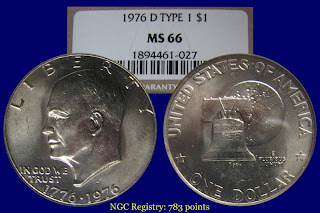 It has been a while since I have showed off a new purchase and I wanted to show off my 1976 Type 1 Eisenhower Dollar graded MS66 by NCG. While some may not think this exciting, it is a very good looking coin that helps boost the score of my registry set collection.
It has been a while since I have showed off a new purchase and I wanted to show off my 1976 Type 1 Eisenhower Dollar graded MS66 by NCG. While some may not think this exciting, it is a very good looking coin that helps boost the score of my registry set collection.
For those new to reading this blog, I wrote about Competitive Collecting which is collecting high grade coins and attempting to complete Registry Sets by the major third party grading services. Those competing in the registry set competitions, try to collect the highest grade coins. Those coins are assigned points and those with the most points wins each year.
I started by dabbling in registry set collecting at the end of 2006. I became more serious in 2007. By the end of 2007, I decided that if I was going to compete, I wanted to win. Since I have an interest in bicentennial numismatics, I decided to clean out the sets I am no longer interested in collecting and just collect 1976 registry coins.
For 2008, I decided to try to find the best coins I can afford in order to have a top registry set. I started with upgrading my Eisenhower Dollars. But these high grade large dollars are not easy to find since they were never struck well. For registry set collectors, higher graded coins can give a registry set a nice point boost. Also, since finding these high grade dollars are difficult, it is satisfying when I find a nice coin.
When I found that this coin was available, I looked up the registry set value and found that removing the previous coin and adding this one would raise my point total by 616 points. Even more important, it would propel me to third place for the 1776-1976 Clad Mint Set competition. I could not resist buying the coin.
After adding the coin to my registry set, I found that the signature banner produced by NGC has added “An NGC Top Ranking Set” to the bottom of the banner for having the third ranked set. This is so cool and such a great ego boost, I downloaded the current banner so I can have a copy.

How cool is that!
Nov 15, 2007 | coins, dollar, registry sets, shows
Rather than reviewing a document, I am day dreaming about what I will find in Baltimore tomorrow. My biggest concern is how the price of gold and silver will effect coin prices. As I type this, gold closed at $787.20—hovering around the magic $800 price for most of the week—and silver closed at $14.52—nudging towards $15. Precious metals price watching has not been a big financial sport since the boom in 1980. We have already seen where it has affected the price of coins from the US Mint.
But I could be just worrying since I am not in the market for anything significant. In fact, I may be selling more than buying! After thinking about it, I decided to sell my set of modern dollars. The only coins worth more than $100 are a 1971 Eisenhower Dollar graded MS-65 by NGC and a 1999-P Susan B. Anthony Dollar with the Narrow Rim graded MS-65 by NGC. I am considering consigning them to one of the online auction houses to see what happens.
Finally, before I get back to work, the US Mint released the James Madison dollar today. As our fourth president, Madison was forced into the War of 1812 when the British Royal Navy blocked American trade with France while Britain and France were at war. The captured seamen were forced into conscription on behalf of the British. It was during the Battle of Baltimore that Francis Scott Key wrote the poem “The Defense of Fort McHenry,“ which is known today as the Star Spangled Banner.
Sep 4, 2007 | coins, registry sets
Here in the United States, the first Monday of September is Labor Day. Labor Day is a United States federal holiday that dates back to 1883 to create a day off for the “working man.” Today, it is a symbolic mark of the end of summer as school begins either the week before or after the holiday.
Along with the start of school comes the start of Meteorological Fall. As opposed to astronomical fall, the meteorological seasons are aligned with the calendar and not the orientation of the Earth from the Sun. It is supposed to signal the beginning of atmospheric cooling.
With the summer over and the return of the routine, this change has me thinking about my collection. While I have a number of interests, including the “oh neat” factor, I have a number of collections that I am assessing whether I want to continue. Of today’s concerns are the dollar coin Registry Sets at the Collectors’ Society. Two of those sets are of a Susan B. Anthony Dollar uncirculated and proof Registry Sets. Although these sets are 50-percent completed, I am just not interested any more. I might keep the 1979 Wide Rim dollar because it is worth a bit more than the others. But the rest of the coins my be sold soon.


I also feel the same about my Eisenhower Dollar Registry sets. Aside from being my first set, I find the coin appealing as the last large dollar coin produced in the United States. But like my Susie B. sets, that spark is no longer there. If I sell this set, all but the 1976 dollars will be sold, including the 1971 coin graded MS65 where NGC Census reports that no 1971 Eisenhower Dollar has graded higher than MS66. This makes my MS65 worth a bit more than other coins of the same grade.


Regardless of what I do with these sets, I will continue to build the Bicentennial and the uncirculated American Silver Eagle sets. In fact, I have a number of coins I sent to NGC for grading that I hope improves my scores. I still like the competitive aspect of Registry sets as I wrote about in Competitive Collecting. But there is no need to collect something I am not interested in just for the competition.



If I decide to sell off the Eisenhower and Susan B. Anthony dollars, I will be posting them on eBay. Watch that space for these coins, possibly including the 1971 dollar that brings in over 300 registry points!
Jul 2, 2007 | Baltimore, Canada, coins, currency, Israel, personal, registry sets, shows
When Friday rolled around, I needed a break. I needed something to take my mind off the daily grind of trying to guide the government to do right with technology. I needed coins. Lots of coins. More coins than can be experienced even when contained under one roof. I needed the Whitman Baltimore Coin and Currency Convention.
After sleeping in, I woke to kiss my wife goodbye and started to pack my backpack. Into the bag went the current editions of the Coin Dealer Newsletter, my Palm T|X that stores my inventory list, my iPod for the trip to Baltimore, and a loupe. I finished my morning constitutional before feeding and walking the dog. After a bite to eat and throwing two bottles of water in my backpack, I was off to Charm City.
The trip to Baltimore is a little more than an hour from home. It is a trip down I-270, across the top of the Capital Beltway, then north on I-95. The trip down I-395 into Baltimore passes M&T Bank Stadium, home of the Baltimore Ravens, to the warehouse beyond right field at Camden Yards home of the Baltimore Orioles. I parked in my usual lot at the Sheraton and walked through the hotel to the walkway to the Baltimore Convention Center.
 This is Whitman’s second time running this show and their mark was seen riding down the escalator when I noticed that the food court was moved. Rather than being outside the door, the service area was moved to the front lobby at the foot of the escalator. The tables were moved out closer to the lobby and Whitman placed convention-style booths for registration. Also, the entrance had a new canopy announcing the show. It looked more professional than in the past.
This is Whitman’s second time running this show and their mark was seen riding down the escalator when I noticed that the food court was moved. Rather than being outside the door, the service area was moved to the front lobby at the foot of the escalator. The tables were moved out closer to the lobby and Whitman placed convention-style booths for registration. Also, the entrance had a new canopy announcing the show. It looked more professional than in the past.
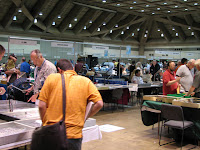 It is still an awe inspiring experience to walk into the hall and see wall-to-wall dealer tables. Adding to the depth of vision was the framing that Whitman used during the last show behind the tables to allow dealers to hang banners. As I began to walk to the left side of Hall A, I noticed that Whitman placed stickers on the floor to mark the row numbers. Looking up, on the columns, they also placed numbered signs showing row numbers and the table number group. The best way I can describe this is that the numbers resemble address numbers on street signs. It is a small touch, but when looking for a specific dealer it really helps.
It is still an awe inspiring experience to walk into the hall and see wall-to-wall dealer tables. Adding to the depth of vision was the framing that Whitman used during the last show behind the tables to allow dealers to hang banners. As I began to walk to the left side of Hall A, I noticed that Whitman placed stickers on the floor to mark the row numbers. Looking up, on the columns, they also placed numbered signs showing row numbers and the table number group. The best way I can describe this is that the numbers resemble address numbers on street signs. It is a small touch, but when looking for a specific dealer it really helps.

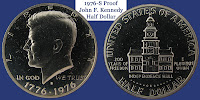 I saw a number of dealers I have bought from and spoken with in the past. Of note I was able to speak with Wayne Herndon, author of the last-page article in July’s Numismatist. The article is really good dry, tongue-in-cheek humor that I found fit Wayne’s personality when you talk with him. Wayne is a good guy and a very fair dealer. From Wayne, I was able to find some 1976 coins that I want to submit to NGC for the registry set. Finding really nice Eisenhower Dollars is very difficult, but Wayne had this 1976-D Type 1 Dollar that I could not pass up. Amongst the other coins I bought was a 1976-S Proof JFK Half Dollar is beautiful.
I saw a number of dealers I have bought from and spoken with in the past. Of note I was able to speak with Wayne Herndon, author of the last-page article in July’s Numismatist. The article is really good dry, tongue-in-cheek humor that I found fit Wayne’s personality when you talk with him. Wayne is a good guy and a very fair dealer. From Wayne, I was able to find some 1976 coins that I want to submit to NGC for the registry set. Finding really nice Eisenhower Dollars is very difficult, but Wayne had this 1976-D Type 1 Dollar that I could not pass up. Amongst the other coins I bought was a 1976-S Proof JFK Half Dollar is beautiful.
Watch out NGC, these coins (and other coins) will be sent this week!
One thing I noticed was that there was a lot of table sharing. While this is a common practice with small dealers, there were some higher volume dealers sharing tables, especially on the corners. For the buyer, this meant that there were more options. I was able to pickup some nice items while junk box diving for resale that I will be posting on eBay soon. Yes, there were some nice items in many of the junk boxes which was surprising.
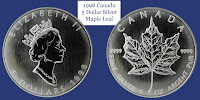 I also had taken the opportunity to try to complete my set of Silver Maple Leaf coins. I was able to find a 1989, 1992, 1996, and 1998. All I am missing from the set is 1990 and 2007. I forgot about the 2007 and did not buy one at the show. All are beautiful coins, but the 1998 is the best. Images of these coins are difficult, but I tried so I can show off their beauty.
I also had taken the opportunity to try to complete my set of Silver Maple Leaf coins. I was able to find a 1989, 1992, 1996, and 1998. All I am missing from the set is 1990 and 2007. I forgot about the 2007 and did not buy one at the show. All are beautiful coins, but the 1998 is the best. Images of these coins are difficult, but I tried so I can show off their beauty.
 As I complete many of my United States sets, I am looking for other areas to explore. One area of interest is the currency of Israel. Coins are interesting, but the Israeli paper is beautiful with nice historical images. But first, I wanted the 2005 Theory of Relativity Commemorative Proof. I purchased a beautiful proof coin from noted dealer in Israeli Numismatics, J.J. van Grover. Van Grover is also the Vice President of the American Israel Numismatic Association, an organization which I recently joined, and we had a chance to talk about AINA and other Israeli issues. But the coin is beautiful whose image cannot do it justice.
As I complete many of my United States sets, I am looking for other areas to explore. One area of interest is the currency of Israel. Coins are interesting, but the Israeli paper is beautiful with nice historical images. But first, I wanted the 2005 Theory of Relativity Commemorative Proof. I purchased a beautiful proof coin from noted dealer in Israeli Numismatics, J.J. van Grover. Van Grover is also the Vice President of the American Israel Numismatic Association, an organization which I recently joined, and we had a chance to talk about AINA and other Israeli issues. But the coin is beautiful whose image cannot do it justice.
I did buy some Israeli paper money. These two notes are from the Fourth Series Pounds dated 1973 but issued in 1975. These notes were demonetized in 1983.
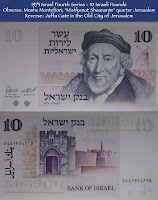

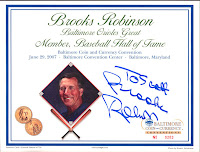 Before going through the rest of the show floor, it was time to take a pause to do something non-numismatic. Appearing at the show was Baltimore Orioles Great and Member of the Baseball Hall of Fame, Brooks Robinson. Robinson is a very gracious gentleman whose current wrist injury he blames on old age. At 70, he may not be able to defend the hot corner but he is not ready for the home either. I did stand on line for his autograph and have my picture taken. Even though my Mets beat his Orioles in 1969, I cannot deny that he was a great player and a classy person. It was a joy to meet him.
Before going through the rest of the show floor, it was time to take a pause to do something non-numismatic. Appearing at the show was Baltimore Orioles Great and Member of the Baseball Hall of Fame, Brooks Robinson. Robinson is a very gracious gentleman whose current wrist injury he blames on old age. At 70, he may not be able to defend the hot corner but he is not ready for the home either. I did stand on line for his autograph and have my picture taken. Even though my Mets beat his Orioles in 1969, I cannot deny that he was a great player and a classy person. It was a joy to meet him.
 Before returning to the bourse floor, I stopped at the nearby Whitman booth. During registration, we were given a coupon for a free copy to The Expert’s Guide to Collecting & Investing in Rare Coins, the latest tome from Q. David Bowers, with a $25 purchase. I almost walked away from the booth before noticing Whitman was selling something that was not numismatic or philatelic related. Whitman now creates something called Football Vault Books. With the publisher from the south, it is not surprising that the series started to cover the Southeastern Conference. When I found the University of Georgia Vault Book I decided to use my coupon after buying the book. The Vault Book is fantastic! It has the history and reproduction of memorabilia from the era being discussed. Ok… back to the coins.
Before returning to the bourse floor, I stopped at the nearby Whitman booth. During registration, we were given a coupon for a free copy to The Expert’s Guide to Collecting & Investing in Rare Coins, the latest tome from Q. David Bowers, with a $25 purchase. I almost walked away from the booth before noticing Whitman was selling something that was not numismatic or philatelic related. Whitman now creates something called Football Vault Books. With the publisher from the south, it is not surprising that the series started to cover the Southeastern Conference. When I found the University of Georgia Vault Book I decided to use my coupon after buying the book. The Vault Book is fantastic! It has the history and reproduction of memorabilia from the era being discussed. Ok… back to the coins.
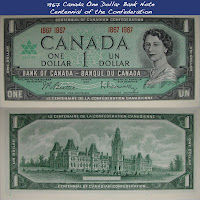 This time, the foreign section was smaller than usual. I was looking for some Canadian coins but was a little disappointed at the selection and the lack of dealers with good Canadian inventory. Rather than walk away empty handed, I bought a 1967 Centennial of the Confederation One Dollar note. It is a crisp, uncirculated note that has a look very reminiscent of the formal aspects of the 1960’s.
This time, the foreign section was smaller than usual. I was looking for some Canadian coins but was a little disappointed at the selection and the lack of dealers with good Canadian inventory. Rather than walk away empty handed, I bought a 1967 Centennial of the Confederation One Dollar note. It is a crisp, uncirculated note that has a look very reminiscent of the formal aspects of the 1960’s.
 As the day was winding down, I needed to buy something old. Somebody had to have something not that expensive but old and fun. I happened upon the table for The Butternut Company out of Clifton, Virginia. Butternut has a nice business of Civil War memorabilia along with the coins. But the had a junk box of well worn large and half cents. Ah ha! Something old! So I searched the small box looking for something with a readable date. In the box I found an 1803 Large Cent that satisfied my old and fun criteria. It is 204 years old and is just loaded with history.
As the day was winding down, I needed to buy something old. Somebody had to have something not that expensive but old and fun. I happened upon the table for The Butternut Company out of Clifton, Virginia. Butternut has a nice business of Civil War memorabilia along with the coins. But the had a junk box of well worn large and half cents. Ah ha! Something old! So I searched the small box looking for something with a readable date. In the box I found an 1803 Large Cent that satisfied my old and fun criteria. It is 204 years old and is just loaded with history.
As I left with ten minutes to closing, dealers were already closing down and vacating. I walked through the Sheraton, purchased a beverage and candy bar from the hotel shop, and retrieved my car from their lot. I left driving around traffic on their way to an Orioles game and found my way to I-395 to head back to the Washington, DC area. During the trip I called my wife to discuss dinner plans and made good time going south on I-95 to the Capital Beltway. I picked up something for dinner and headed home. After being happily greeted by Boomer, I cleaned up and served dinner while telling my wife about the fun I had. Show-and-tell occurred before desert.
In all, it was a wonderful day and a wonderful show.
Click on any image to enlarge. Vault Book cover from Whitman Publishing.
Feb 10, 2007 | coins, grading, registry sets
My collecting philosophy is that whatever intrigues me, I will collect. My collection consists mostly of 20th century coins with the moderns complete through 2006. But as I have been filling holes in my albums with nice coins, I am missing the thrill of the hunt—the thrill of searching for something neat to fill those holes in the albums.
When I restarted collecting following my first wife’s untimely death, it was to have a diversion to get my mind off of recovering from that loss. As I expanded my interests, I started to buy albums and coins to put in those albums. I would buy coins in lots, take what I want and resell them elsewhere. It was fun, even when I bought those packages with pounds of coins. But some of the collections are complete and in others, I am missing some of the key dates.
The hunt was revived a little when I started to look into large cents and Morgan Dollars. Large and half cents are intriguing as they represented the founding father’s desire to ensure even those at the lowest levels can participate in the building economy. For example, the half-cent was struck so that change could be properly made when something costed “bits” one-eighth of the Spanish milled dollar or 12½ cents (a bit), the de facto currency of the new country.
That has been interesting, but there has to be more.
Fans of the Food Network have seen the various ways of turning cooking into competition. Numismatics has its own version of competition called Registry Sets. Registry sets are competitions amongst collectors to see who can put together the finest graded coins in a particular category. Categories range from date sets to date and mint mark sets to year sets. There are various categories for any interest.
Registry set competition is sponsored by PCGS and NGC individually. PCGS restricts registry sets to PCGS graded coins. NGC allows the NGC and PCGS graded coins in their registry set. Both services allows competitors to enter the information about their coins via the web, include pictures, and a short write up of the entry. PCGS’s web-based interface is recognized as being more user friendly. At the end of the year, both services recognizes the best sets as the best representation of the category they are entered.
Once I became interested with the registry set competition, I chose to compete for sets at NGC because of the ability to register both NGC and PCGS graded coins. It allows for more flexibility. Then I had to decide what sets to compete with. I started with uncirculated American Silver Eagle coins because I had a few already graded. But there is a lot of competition and I have not been collecting the highest grade in order to compete.

Previously, I had started to collect quarters, halves, and dollars from 1976 with the bicentennial commemorative reverses. These were the first changes in coinage during my life time and I remember the exuberance over the celebration. I really like the designs and I think were successful modern type coins. I submitted the best coins I had to NGC for grading and started my bicentennial set. NGC does not have a bicentennial set, but they have year sets for mint state, silver, and proof bicentennial coins. Then I started to purchase coins to complete the sets. My Mint State set is now fifth in the competition! I like having a set ranked that high, but I want it at least in the top three. I have the rest of this year to complete and improve this set!
As a side effect of this, I have been collecting the last large dollar series produced by the Mint. Eisenhower dollars are the last of the large dollars. These large metal pieces were not widely accepted and only lasted eight years. But I find them intriguing and started both mint state and proof sets. The mint state sets are missing the more expensive 1972 die types and the 1976 coins need to be upgraded, but as I said, there is time to fix this.
I would like to try to come up with a top ranked set. I am close with the mint state bicentennial set, but I have to upgrade those dollars. In the mean time, I am having fun putting together the sets, which this is all about!
Registry sets add a different slant on collecting and can be fun. You may want to give it a try.
 Last month, the American Numismatic Association announced that they have partnered with Numismatic Guarantee Corporation (NGC) to launch the ANA Coin Registry.
Last month, the American Numismatic Association announced that they have partnered with Numismatic Guarantee Corporation (NGC) to launch the ANA Coin Registry.





















